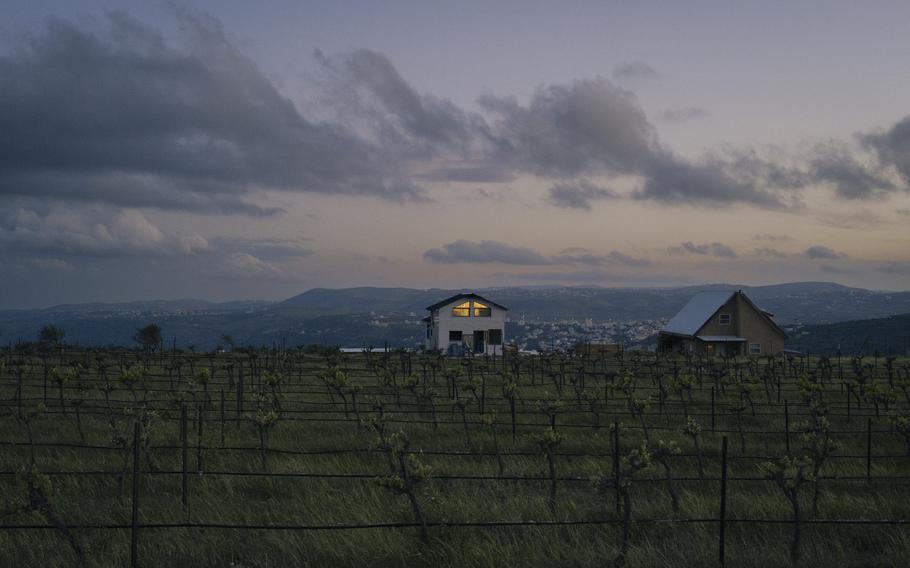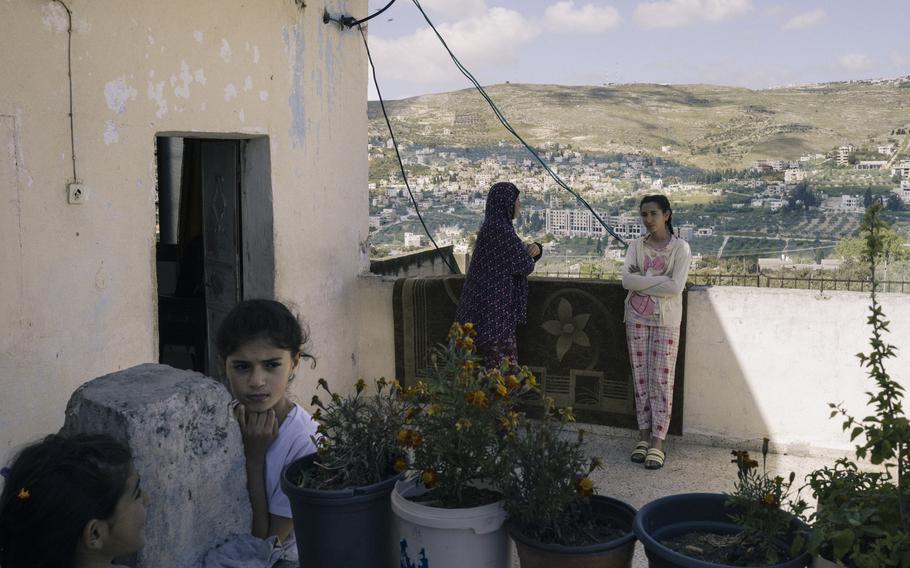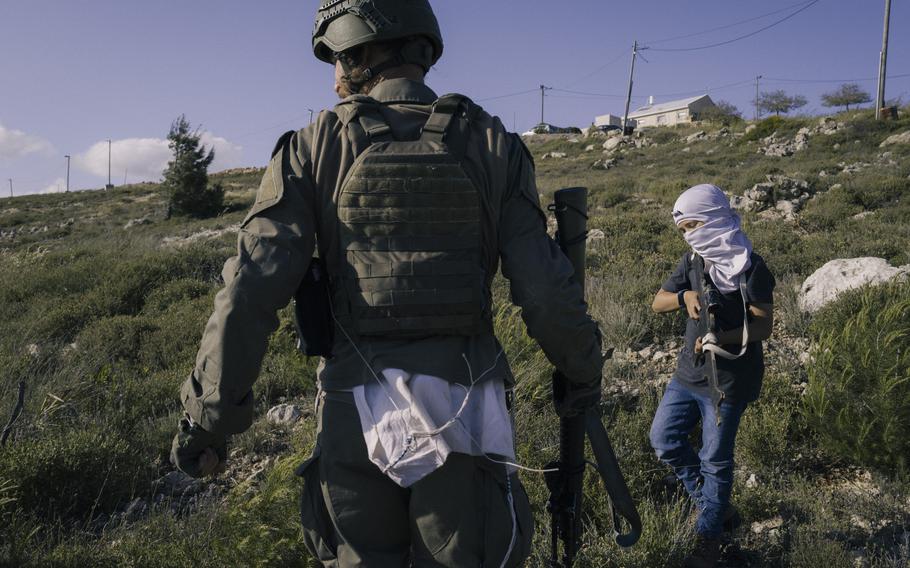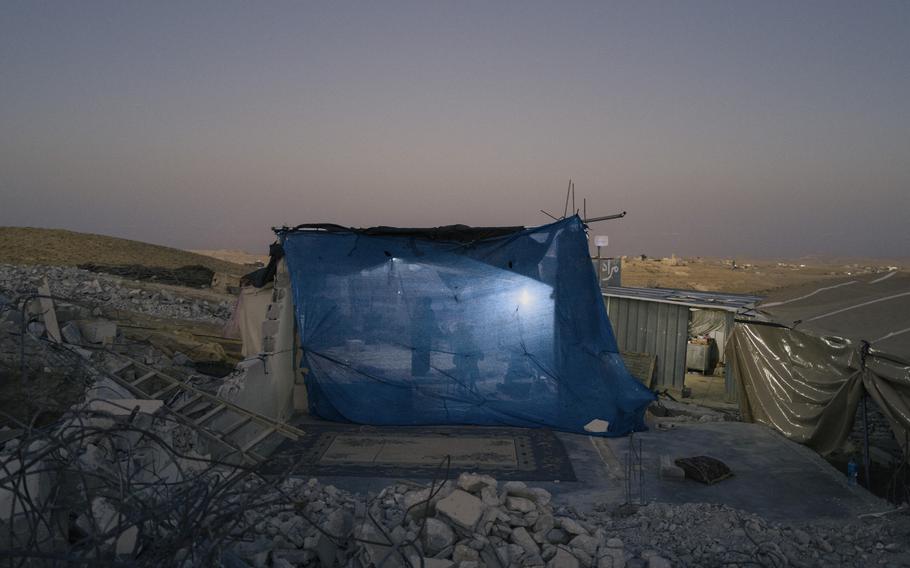Middle East
Israel is redrawing the West Bank, cutting into a prospective Palestinian state
The Washington Post August 15, 2024

Ahiya, an outpost of the Shilo settlement, is in the process of being legalized by the government, 27 years after the first settlers arrived there. (Lorenzo Tugnoli/The Washington Post)
During more than 19 months in power, Prime Minister Benjamin Netanyahu’s coalition government has dramatically expanded Israel’s footprint in the occupied West Bank — accelerating a long-term campaign by the country’s settler movement to thwart the creation of a Palestinian state.
The government has approved strategic land seizures — almost 6,000 acres this year alone — and major settlement construction, escalated demolition of Palestinian property and increased state support for illegally built settler outposts. Together, they mark the most significant territorial changes in the West Bank in decades.
While the Biden administration insists that any diplomatic solution to the war in Gaza include a path to an independent Palestinian state, radical Jewish settlers and their far-right political backers, who have ascended to the highest levels of Israel’s government, are redrawing the map in real time — making the two-state solution envisaged in past peace accords effectively impossible.
In interviews across six Palestinian communities, residents described paralyzing constraints on daily life as settlements creep closer, limiting their ability to move freely and to access the farmlands that long sustained them. Settler violence has erased some villages.
Netanyahu, Israel’s longest-serving prime minister, returned to office in December 2023 on the basis of a coalition agreement that promised to “promote and develop settlement in all parts of the Land of Israel,” including Judea and Samaria, as the West Bank was called in biblical times.
The effort to expand and solidify Israeli control of the area is led by Bezalel Smotrich, a longtime settler activist who now serves as finance minister. Netanyahu also appointed him last year to a post within the defense ministry, giving him wide powers over Israeli policy in the West Bank.
Smotrich’s driving ambition is “to settle the land, to build it, and to prevent, for God’s sake, its division ... and the establishment of a Palestinian state,” he told his Religious Zionism Party at a conference June 9, according to an audio recording obtained by Peace Now, an Israeli rights group that has spent decades documenting the growth of the settler movement.
To achieve that goal, Smotrich said, he would need to “change the DNA of the system.”
An estimated 3 million Palestinians live in the West Bank, alongside more than 500,000 settlers, whose numbers have increased by more than 15 percent during the past five years.
The position of Smotrich and his allies at the levers of power has turbocharged their gains. Israel’s Higher Planning Council has fully approved almost 12,000 housing units in settlements in the past 19 months, compared with just over 8,000 in the prior two years, according to Peace Now. A growing number of West Bank outposts — illegal under Israeli law — have been legalized. Large tracts of land have been seized by the state.
Successive American administrations have criticized Israeli settlements as an obstacle to peace. In February, after Smotrich announced plans for 3,000 housing units in the West Bank, Secretary of State Antony Blinken said the Biden administration considered settlements “inconsistent with international law” — a position first codified in 1978, under President Jimmy Carter, and reversed in 2019 by President Donald Trump.
Biden has also imposed sanctions on illegal settler outposts, and on Israeli settlers accused of attacking Palestinians. Yet the executive actions have appeared to have little effect on the expansion of settlements or the explosion of settler violence.

A farmer in Qaryut in the West Bank walks near a greenhouse in April that was destroyed by settlers. (Lorenzo Tugnoli/The Washington Post)
Israeli security forces have failed to halt a rising tide of harassment, assault and murder by extremist settlers, aimed at depopulating the Palestinian communities around them. At least 114 Palestinians have been killed or wounded in those attacks since October, according to the United Nations. While the military has dismantled some illegal outposts, most are quickly rebuilt.
“Any claim that the IDF supports and permits settler violence is false,” the Israel Defense Forces said in a statement to The Washington Post.
The U.N.’s highest court ordered Israel last month to end its occupation of Palestinian territory, evacuate existing settlements and pay reparations to Palestinians who have lost land and property — a symbolically significant ruling, but one with limited practical effect.
Netanyahu was quick to blast the decision. “The Jewish people are not conquerors in their own land,” he said.
New rulers
The West Bank has been under military occupation since Israel seized the territory in 1967, giving commanders oversight of administrative, legal and civilian affairs. Under the terms of the U.S.-brokered Oslo accords, Israel has full control over Area C — which makes up 60 percent of the land — though its forces also operate in Areas A and B, nominally administered by the Palestinian Authority.
In late May, the IDF announced that significant management powers over the West Bank were being reassigned to a newly created “deputy head” position within the Civil Administration, Israel’s governing body in the West Bank. That same day, the role was given to Hillel Roth, a close Smotrich associate.
Transferring military control to a handpicked civilian was seen as another step toward Smotrich’s long-running aspiration, outlined in a 2017 treatise, to achieve “victory by settlement” and extend Israeli law over the territory — which experts say would effectively convert occupation into annexation.
Roth lived for years in Yitzhar, known as one of the most violent West Bank settlements. He is now empowered to make sweeping decisions about new construction in the territory and the administration of state land. Roth declined to comment for this report. Smotrich did not respond to multiple requests for comment.
“What Smotrich is doing is cementing a situation where every single aspect of Palestinian lives in the West Bank is determined by an Israeli civilian,” said Sarit Michaeli of B’Tselem, one of Israel’s leading human rights groups.
In June, a Pew Research Center poll showed that 49 percent of Jewish Israelis think the continued building of Jewish settlements in the West Bank helps the country’s national security, while 26 percent said it hurts.
The settler movement has worked patiently for decades to reach this point. For years, a glance at a map of the West Bank would have yielded few clues to what was coming. Land seizures were incremental; the placement of some settlements may have appeared illogical at first glance.
Over time, smaller settlements were consolidated into blocs. Highways and bypass roads connected them to Israel proper.

The village of Burin has been almost completely encircled by settlements. The Soufan family lives near one of them. (Lorenzo Tugnoli/The Washington Post)
The state has used “planning and building as a weapon to conquer more land,” said Alon Cohen-Lifshitz, a coordinator with Bimkom, a group of Israeli urban planners and architects who help Palestinians navigate the system. The main aim, he said, was to create a “matrix of control.”
When the military had final say over all new construction and development, he said, there were limits to how that matrix could be expanded. With Roth at the helm, the process has accelerated.
One of his first moves was to approve the largest West Bank land seizure in more than three decades — declaring almost five square miles in the Jordan Valley as state land, opening it up to leasing by Israelis while prohibiting private Palestinian ownership. Peace Now said that the move could allow for the connection of four Israeli settlements along a key corridor bordering Jordan.
Encirclement and expansion
Palestinians in the West Bank describe a creeping, decades-long encirclement by settler communities, followed more recently by rapid expansion and unchecked violence.
The Shilo settlement was established in the late 1970s on land confiscated from two neighboring Palestinian villages: Qaryut and Turmus Ayya. “It started with a few people, like Boy Scouts,” said Yousif Sadiq, deputy head of Qaryut’s local council. “Back then, we could herd our sheep between the two, never leaving our own private land.”
In 2011, Israel’s Defense Ministry approved a plan to increase the settlement’s housing units by 60 percent, local media reported. By late 2023, the village was almost surrounded by legal settlements and illegal outposts; harassment from soldiers and settlers led some residents to add bars and barbed wire to their homes.
Then came Oct. 7, when Hamas fighters poured into southern Israel, killing around 1,200 people and taking more than 250 hostages to Gaza.
“Now, if settlers try to take a hill, the army will protect them, then the state will give them electricity and water,” said Bashar Ma’amar, a paramedic and activist from Qaryut who records attacks by Israeli settlers. The outposts can be seen from the village; sounds of construction are carried on the hot summer air.
Across the West Bank, the pace of settler attacks has doubled under Netanyahu’s coalition government, according to the U.N. On July 31, the agency’s humanitarian affairs office said it had recorded 1,143 separate incidents since the start of the war. Five Israeli settlers have been killed by suspected Palestinian militants during the same time period, according to the U.N.

Settlers train for quick response to security threats in the settlement of Shilo in April. (Lorenzo Tugnoli/The Washington Post)
In Qaryut, a large green belt of olive groves and vegetable fields sit untended. Villagers say they have been fired upon as they approach the area. They shared videos with The Post showing settlers bulldozing olive trees and burning crops.
“The IDF is committed to the well-being of the residents of the area and acts vigorously against manifestations of violence within its jurisdiction,” Israel’s military told The Post when asked what actions it had taken to stem settler violence in Qaryut. It referred questions to the Israel Police, which did not respond to requests for comment.
At the southern end of the village, settlers have spray-painted the walls of a now-abandoned children’s playground with a Star of David and a rifle. The water tank that once fed Qaryut has been hacked open and turned into a swimming pool for settlers.
On a recent afternoon, boys did somersaults before plunging into the cool water. Most were from a yeshiva in the nearby settlement of Eli; none knew the name of the Palestinian village perched on the top of the hill. Settlers had blocked the road with large broken boulders.
“With our snipers, it’s hard for anyone to come down from there now,” said one teenager. “It makes me feel safer like that.”
While new construction solidifies existing settlements like Shilo and Eli, the outposts that surround them provide an informal road map for expansion, watchdog groups say.
In February 2023, Israel’s cabinet designated nine illegal outposts as “sites under legalization” — a designation rarely used under previous administrations — promising government funds, connection to state power and water grids and an exemption from demolitions.
When Adalah, an Israeli legal rights group, challenged the decision as a breach of international law, Netanyahu’s Cabinet Secretary Yossi Fuchs replied: “Israel is not an occupying power,” he wrote in a letter dated March 9 and shared by the group. He then quoted from the First Book of Maccabees: “It is not a foreign land we have taken nor have we seized the property of foreigners, but only our ancestral heritage, which for a time had been unjustly occupied by our enemies.”
Smotrich’s Settlement Administration has since given the same designation to at least 60 other illegal outposts, according to Peace Now.
In April, the government announced its intention to legalize the outpost of Ahiya, a jumble of portacabins perched on a windswept hilltop near Qaryut, 27 years after the first settlers arrived there.
Inside one cabin, security guards monitored a bank of CCTV cameras that showed the surrounding roads. “The principle we live by here is one of mission,” said a guard, declining to give his name. “They understand that we would kill to stay.”
Later, the security team simulated their response to an infiltration by militants. Men in green uniforms scanned the hillside, rifles in hand, looking for a young boy from the settlement who was dressed as an Arab.
Demolitions
As Israeli settlements expand and outposts are incorporated, Palestinian communities are being whittled away through demolitions and denials of building permits.
More than 2,000 structures have been demolished in the West Bank, including East Jerusalem, under Netanyahu’s new government, according to the United Nations, displacing more than 4,000 people — 2,200 people were displaced in the two years prior.
In the south Hebron hills, the villagers of Umm al-Kheir don’t know how much longer they can hold their ground.
When Eid Yameen al-Hathaleen was forced from his home in the Negev desert during the founding of Israel in 1948, the Bedouin patriarch resettled on land belonging to a Palestinian family, who later sold it to him, his son Yasser said.
The family grew and the village expanded to about 250 people. In the early 1980s, the Israeli settlement of Carmel was established next door. Israel issued the first demolition orders against houses in Umm al-Kheir in 1995, residents said; the first demolition was carried out in 2007. After a slew of demolitions in 2014, the village was spared for years.
On the morning of June 26, residents awoke to warnings that the Israeli army and police were approaching with bulldozers. Within hours, a cluster of houses belonging to Yasser had been smashed to pieces.

The family of Yasser al-Hathaleen gathers in July amid in the wreckage of one of the houses that was demolished in Umm al-Kheir. (Lorenzo Tugnoli/The Washington Post)
“We were left without homes, without shelter, under the sun, in the dirt,” Yasser said, sitting under a tent his neighbors had built for his sprawling family, as temperatures climbed above 100 degrees. His young sons played next to the wreckage.
Eleven structures were destroyed that day, including a communal tent, which had served as a health clinic and a place where villagers had married and celebrated the birth of babies.
The IDF said in a statement that the demolitions took place because the structures were built without a permit. “The law was enforced in their case according to all the procedures and by force of law,” it said. The Israel Police did not reply to requests for comment about their reported participation in the operation.
Umm al-Kheir’s residents applied for a master plan — a requirement for official recognition by Israel — in 2016, but it was “never discussed,” according to Tariq al-Hathaleen, Yasser’s nephew.
Palestinians are denied access to special local planning committees available to Jewish settlers. Land designated for Palestinian construction comprises only 0.5 percent of Area C, compared with 26 percent of Area C in which settlers are authorized to build, Cohen-Lifshitz said, citing Bimkom research and Israeli government data obtained through the country’s freedom of information law.
“In the West Bank, we can really say it’s official apartheid, because you have completely different laws for Palestinians and for Israelis,” he said.
In Umm al-Kheir, as in other villages, home demolitions have emboldened aggressive settlers nearby.
The evening before Post reporters visited the community July 2, several young settlers led their sheep to the village’s feed pen, witnesses said. When local women tried to get them to leave, the settlers beat them with sticks and stones and pepper sprayed their faces.
An hour after Post reporters departed, settlers pitched a tent in Umm al-Kheir as Israeli soldiers watched and joked with them, according to residents and videos taken by Israeli activists. The police force took two hours to arrive, and when they did, they told the villagers to file a complaint, witnesses said.
In a statement, the IDF said that the soldiers had arrived to “prevent friction until the arrival of additional forces and the Israeli Police.” The police did not respond to a request for comment about why they took so long to arrive or why they did not do more to intervene.
On Tuesday, the bulldozers returned to Umm al-Kheir, demolishing shelters set up for families whose homes were destroyed earlier this summer. They had been rebuilt “in violation of the law locally in effect,” according to Israel’s Civil Administration.
“We have nowhere to go but to God,” Yasser said.
In early July, Israeli forces descended with heavy machinery on another hilltop in the West Bank — this time to demolish an illegal settler outpost. Young men at Givat Tzur Harel, north of Ramallah, clashed with security forces as they razed several structures.
It was a rare example of Israeli authorities cracking down on illegal building by Jewish settlers. “Whenever an outpost is demolished, it is usually rebuilt within an hour to a day,” said Arik Ascherman, a rabbi from Torat Tzedek, an Israeli rights group.
The police would leave and the young settlers would return, said one teenager. His friend Haggai, 17, said he hoped the new civilian administration headed by Roth would be more lenient.
A fundraising drive for the “heroes who colonize the land of Tzur Harel” quickly raised thousands of shekels.
“The day will come when this place will be a settlement,” said Haggai, who declined to give his last name. “We have four directions to advance. All of the Land of Israel should belong to the Jews.”
Lior Soroka and Alon Rom in Tel Aviv contributed to this report.